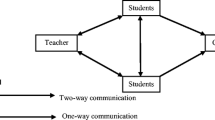Abstract
The Just-in-Time Teaching (JiTT) technique allows students to be engaged in course material outside of the classroom by answering web-based questions. The responses are summarized and presented to students in class with a follow-up active learning exercise. College students enrolled in an introductory-level general education geoscience course were surveyed over a two-semester period on their engagement level during lecture and perceived learning of course content. Data show that students are able to reflect on their prior knowledge and construct new knowledge with weekly graded JiTT exercises. Despite increasing and competing pressures outside of the classroom, students reported increased learning and engagement in a course with required weekly assignments.
Similar content being viewed by others
References
Benedict JO, Anderton JB (2004) Applying the Just-in-Time Teaching approach to teaching statistics. Teach Psychol 31:197–199
Bloom BS (1956) Taxonomy of education objectives, handbook I: the cognitive domain. David McKay Co. Inc., New York
Conner-Greene PA (2000) Assessing and promoting student learning: blurring the line between teaching and testing. Teach Psychol 27:84–88
Cookman C (2004) Improving students’ critical thinking skills through Internet technology: just in time teaching in a history of photography course. IS-SOTL Conference, October 23, 2004
de Caprariis P, Barman C, Magee P (2001) Monitoring the benefits of active learning exercises in introductory survey courses in science: an attempt to improve the education of prospective public school teachers. J Sch Teach Learn (JoSoTL) 1:1–11
Edwards ME, Cordray S, Dorbolo J (2000) Unintended benefits of distance-education technology for traditional classroom teaching. Teach Sociol 28:386–391
Gottfried S, Hoots R, Creek R, Tamppari R, Lord T, Sines RA (1993) College biology teaching: a literature review, recommendations, and a research agenda. Am Biol Teach 55:340–348
Grove K (2002) Using online homework to engage students in a geoscience course for general education. J Geosci Educ 50:566–574
Hake RR (1998) Interactive-engagement versus traditional methods: a six-thousand-student survey of mechanics test data for introductory physics courses. Am J Phys 66:64–74
Keefer R (1998) Criteria for designing inquiry activities that are effective for teaching and learning concepts: constructing effective inquiry-based lessons. J Coll Sci Teach 28:159–165
Kilonsky DJ (2001) Constructing knowledge in the lecture hall. J Coll Sci Teach 31:246–251
King P, Hildreth D (2001) Internet courses: are they worth the effort? J Coll Sci Teach 31:112–115
Linneman S, Plake T (2006) Searching for the difference: a controlled test of Just-in-Time Teaching for large-enrollment introductory geology courses. J Geosci Educ 54:18–24
Marrs KA, Blake RE, Gavrin AD (2003) Web-based Warm Up exercises in Just-in-Time Teaching. J Coll Sci Teach 33:42–47
Moore R, Miller I (1996) How the use of multimedia affects student retention and learning. J Coll Sci Teach 25:289–293
Mzumara H, Gavrin A, Chisholm R (2001) Webscience: assessment of Just-in-Time teaching at IUPUI. Paper presented at the EDUCAUSE 2001 Conference. Retrieved October 1, 2005, from http://www.educause.edu/ir/library/pdf/EDU0108.pdf
National Commission on Educating Undergraduates in the Research University (1998) Reinventing Undergraduate Education: A Blueprint for America’s Research Universities
National Research Council (1999) How People Learn: Brain, Mind, Experience, and School. National Academies Press, Washington, DC
National Research Council (2000) How People Learn: Brain, Mind, Experience, and School: Expanded Edition. National Academies Press, Washington, DC
National Science Foundation (1996) Shaping the future: new expectations for undergraduate education in science, mathematics, engineering, and technology
Novak GM, Patterson ET (1998) Just-in-Time teaching: active learner pedagogy with WWW. Paper presented at the 1998 IASTED International Conference on Computers and Advanced Technology in Education. Retrieved October 1, 2005, from http://www.webphysics.iupui.edu/JITT/ccjitt.html
Novak GM, Patterson ET, Gavrin AD, Christian W (1999) Just-in-Time teaching: blending active learning with web technology. Prentice Hall, Upper Saddle River, NJ
O’Connell J (2001) Teaching an online physical science course. Phys Teach 39:146–147
Riffell SK, Sibley DH (2003) Learning online. J Coll Sci Teach 32:394–399
Simon HA (1996) Observations on the sciences of science learning. Paper prepared for the Committee on Developments in the Science of Learning for the Sciences of Science Learning: An Interdisciplinary Discussion. Department of Psychology, Carnegie Mellon University
Author information
Authors and Affiliations
Corresponding author
Rights and permissions
About this article
Cite this article
Guertin, L.A., Zappe, S.E. & Kim, H. Just-in-Time Teaching Exercises to Engage Students in an Introductory-Level Dinosaur Course. J Sci Educ Technol 16, 507–514 (2007). https://doi.org/10.1007/s10956-007-9071-5
Published:
Issue Date:
DOI: https://doi.org/10.1007/s10956-007-9071-5




